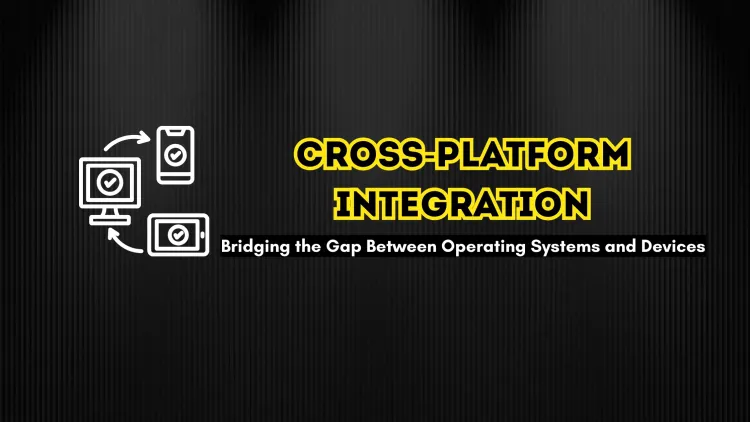Cross-Platform Compatibility and Integration | How Technology Bridges the Gap Between Different Operating Systems and Devices
Cross-platform compatibility and integration enable seamless functionality, data sharing, and communication across different operating systems, devices, and software environments. As businesses and users rely on a mix of Windows, macOS, Linux, Android, and iOS, ensuring compatibility is crucial for efficiency, cost savings, and an improved user experience. This blog explores the importance of cross-platform integration, the challenges developers face, and the technologies driving seamless compatibility, such as cross-platform frameworks, APIs, virtualization, and cloud computing. It also highlights best practices for businesses and developers to create software that functions across multiple platforms. Looking ahead, trends like AI-driven development, blockchain-based security, and 5G-powered edge computing will further enhance cross-platform capabilities, making applications more efficient and accessible.

Table of Contents
- Introduction
- What is Cross-Platform Compatibility?
- The Importance of Cross-Platform Integration
- Challenges in Achieving Cross-Platform Compatibility
- Technologies and Tools Enabling Cross-Platform Integration
- Best Practices for Achieving Cross-Platform Compatibility
- Future of Cross-Platform Compatibility and Integration
- Conclusion
- Frequently Asked Questions (FAQs)
Introduction
In today’s interconnected digital world, cross-platform compatibility and integration play a crucial role in ensuring seamless communication, functionality, and user experience across multiple devices and operating systems. With businesses and individuals using various platforms such as Windows, macOS, Linux, Android, and iOS, the need for software and applications to function consistently across different environments has never been more important.
This blog explores the importance, challenges, benefits, and key technologies behind cross-platform compatibility and how businesses and developers can achieve seamless integration across multiple platforms.
What is Cross-Platform Compatibility?
Cross-platform compatibility refers to the ability of software, applications, and systems to run and interact seamlessly across different operating systems, hardware devices, and network environments.
For example:
-
A mobile application developed for Android and iOS should provide the same features and experience on both platforms.
-
A document created on Microsoft Office on Windows should be readable and editable on macOS and Linux using compatible software like LibreOffice or Google Docs.
Key Elements of Cross-Platform Compatibility
-
Software Portability: Ensuring software runs on different OS without major modifications.
-
Hardware Independence: Applications should work on various hardware configurations.
-
Consistent User Experience (UX): Maintaining uniformity in design and functionality across devices.
-
Data Synchronization: Keeping data updated across multiple platforms using cloud services.
The Importance of Cross-Platform Integration
With businesses operating in hybrid environments that include desktop, mobile, cloud, and IoT devices, ensuring cross-platform integration is crucial. It allows for better collaboration, efficiency, and cost savings while improving the overall user experience.
Why Cross-Platform Integration Matters?
-
Business Efficiency: Enterprises often use a mix of Windows, Linux, and macOS for different teams. Integration enables them to share files, communicate, and use common applications.
-
Improved User Experience: Users can access the same apps, documents, and services regardless of the device they are using.
-
Cost Savings: Instead of developing separate applications for each OS, cross-platform solutions reduce development time and costs.
-
Better Market Reach: Applications that work across platforms can reach a wider audience, increasing adoption rates.
Challenges in Achieving Cross-Platform Compatibility
Despite its advantages, achieving full cross-platform compatibility comes with challenges:
1. OS and Hardware Differences
Each operating system (Windows, macOS, Linux, Android, iOS) has different architectures, system calls, and APIs, making compatibility complex.
2. Performance Issues
Cross-platform applications sometimes experience performance lags compared to native applications optimized for specific platforms.
3. Security Risks
Integrating multiple platforms increases security risks, requiring robust encryption and secure authentication mechanisms.
4. UI/UX Inconsistencies
Different platforms follow different design guidelines (e.g., Material Design for Android, Human Interface Guidelines for iOS), making it hard to maintain a consistent user interface.
5. Software Dependencies
Applications may rely on platform-specific software libraries, making it difficult to run them universally across platforms.
Technologies and Tools Enabling Cross-Platform Integration
Several technologies help developers create cross-platform applications and systems:
| Technology/Tool | Purpose | Example Use Cases |
|---|---|---|
| Cross-Platform Frameworks | Develop apps for multiple OS from one codebase | React Native, Flutter, Xamarin |
| Cloud Services | Sync data across devices and platforms | Google Drive, Dropbox, Microsoft OneDrive |
| Virtualization | Run different OS on a single machine | VMware, VirtualBox, Parallels |
| Web-Based Applications | Apps accessible via browser, independent of OS | Google Docs, Trello, Slack |
| Containerization | Deploy applications consistently across OS | Docker, Kubernetes |
| API Integration | Connect software from different platforms | REST APIs, GraphQL, SOAP |
| Progressive Web Apps (PWAs) | Web applications that function like native apps | Twitter PWA, Uber PWA, Pinterest PWA |
| Middleware Solutions | Bridge the gap between different systems | MuleSoft, IBM WebSphere |
Best Practices for Achieving Cross-Platform Compatibility
To ensure seamless compatibility and integration, businesses and developers should follow best practices:
1. Use Cross-Platform Development Frameworks
Frameworks like Flutter, React Native, and Xamarin allow developers to write code once and deploy it across multiple platforms.
2. Prioritize Web-Based Solutions
Web applications using HTML5, JavaScript, and CSS ensure better accessibility across devices.
3. Implement Cloud-Based Services
Cloud storage and services ensure real-time synchronization and accessibility across devices.
4. Maintain Consistency in UI/UX Design
Design should follow universal UI/UX principles to ensure a seamless experience across all platforms.
5. Perform Cross-Platform Testing
Testing tools like BrowserStack, Selenium, and Appium help detect compatibility issues across different platforms.
Future of Cross-Platform Compatibility and Integration
As technology evolves, new trends are shaping the future of cross-platform compatibility:
1. AI-Driven Cross-Platform Development
AI can assist in automating code conversion, debugging, and performance optimization across platforms.
2. Blockchain for Secure Data Sharing
Blockchain technology ensures secure and decentralized cross-platform data sharing.
3. 5G and Edge Computing
The rise of 5G and edge computing enables faster and more reliable cross-platform data synchronization.
4. Advanced API Standardization
APIs will become more standardized, enabling smoother integration between different apps, platforms, and devices.
5. Increased Adoption of Progressive Web Apps (PWAs)
PWAs are becoming more powerful and can replace native applications for many use cases.
Conclusion
In the modern digital landscape, cross-platform compatibility and integration are vital for businesses, developers, and consumers. From enabling software accessibility across multiple OS to fostering better collaboration and security, cross-platform solutions drive innovation and efficiency.
By leveraging cloud computing, APIs, virtualization, and cross-platform development frameworks, businesses can reduce costs, improve productivity, and enhance the user experience. As technologies like AI, blockchain, and 5G continue to evolve, cross-platform compatibility will play an even bigger role in shaping the future of computing.
Frequently Asked Questions (FAQs)
What is cross-platform compatibility?
Cross-platform compatibility refers to the ability of software or applications to run seamlessly on multiple operating systems and devices without major modifications.
Why is cross-platform integration important?
It allows businesses and users to access the same software and data across different platforms, improving efficiency, reducing costs, and enhancing collaboration.
What are the biggest challenges in cross-platform development?
The main challenges include differences in OS architectures, security vulnerabilities, performance optimization, UI/UX inconsistencies, and software dependencies.
How do cross-platform frameworks help developers?
Frameworks like Flutter, React Native, and Xamarin enable developers to write code once and deploy it across multiple platforms, saving time and effort.
What is the role of cloud computing in cross-platform integration?
Cloud computing allows data synchronization, storage, and processing across different platforms, ensuring a seamless experience for users.
How does API integration improve cross-platform compatibility?
APIs enable different software applications to communicate and share data across platforms, allowing better integration and functionality.
What are some popular cross-platform development tools?
Some widely used tools include Flutter, React Native, Xamarin, Electron, and Unity for gaming applications.
How does virtualization help in cross-platform compatibility?
Virtualization technologies like VMware and VirtualBox allow users to run multiple operating systems on a single machine, improving compatibility.
What is the difference between hybrid and native applications?
Native apps are built specifically for one OS, while hybrid apps use a common codebase and can run on multiple platforms.
What is a Progressive Web App (PWA)?
PWAs are web applications that function like native apps, offering offline access, push notifications, and improved performance across devices.
How does UI/UX design impact cross-platform applications?
Consistent UI/UX design ensures that users have a seamless and familiar experience regardless of the device or operating system.
What role does AI play in cross-platform development?
AI helps automate software testing, code conversion, and performance optimization to improve cross-platform compatibility.
Can cross-platform apps be as fast as native apps?
While native apps generally offer better performance, modern cross-platform tools and optimizations have significantly closed the gap.
What is containerization, and how does it help with compatibility?
Containerization (e.g., Docker, Kubernetes) packages applications with their dependencies, ensuring they run consistently across different platforms.
What security risks are associated with cross-platform applications?
Security challenges include data breaches, API vulnerabilities, inconsistent encryption standards, and malware risks across different environments.
How can businesses ensure security in cross-platform applications?
Using secure coding practices, encryption, authentication mechanisms, and frequent updates helps mitigate security risks.
What is the impact of 5G on cross-platform integration?
5G enables faster data transfer and real-time processing, improving cross-platform connectivity and responsiveness.
How does blockchain enhance cross-platform security?
Blockchain technology provides decentralized and tamper-proof data storage, improving security in cross-platform applications.
How does software testing differ for cross-platform applications?
Cross-platform testing requires testing on multiple operating systems, devices, and browsers to ensure functionality and consistency.
What industries benefit most from cross-platform integration?
Industries such as finance, healthcare, education, e-commerce, and gaming greatly benefit from seamless cross-platform compatibility.
Can enterprise software be integrated across multiple platforms?
Yes, many enterprise solutions use cloud-based services and APIs to enable integration across different operating systems and devices.
What is the future of cross-platform application development?
The future includes AI-driven development, improved API standardization, blockchain security, and enhanced real-time data synchronization.
How do cross-platform applications handle data synchronization?
They use cloud storage and APIs to ensure that data remains updated and accessible across multiple devices.
What is the best approach for mobile cross-platform development?
Using frameworks like Flutter or React Native, implementing responsive design, and testing on different OS versions is the best approach.
What is middleware, and how does it help with integration?
Middleware is software that connects different applications or systems, facilitating communication and data exchange between them.
How can developers maintain UI consistency across platforms?
Following design guidelines from each platform (e.g., Material Design for Android, HIG for iOS) and using adaptable UI frameworks ensures consistency.
How does edge computing support cross-platform applications?
Edge computing processes data closer to the user, reducing latency and improving the performance of cross-platform applications.
Are cross-platform apps more cost-effective than native apps?
Yes, cross-platform apps reduce development and maintenance costs since they use a single codebase for multiple platforms.
Can web applications replace native applications in the future?
With advancements in web technologies, PWAs are becoming more powerful and may replace some native applications in the future.
What are the best practices for cross-platform software development?
Using a modular architecture, testing extensively, prioritizing security, ensuring UI/UX consistency, and leveraging cloud services are key best practices.













![Top 10 Ethical Hackers in the World [2025]](https://www.webasha.com/blog/uploads/images/202408/image_100x75_66c2f983c207b.webp)

![[2025] Top 100+ VAPT Interview Questions and Answers](https://www.webasha.com/blog/uploads/images/image_100x75_6512b1e4b64f7.jpg)








